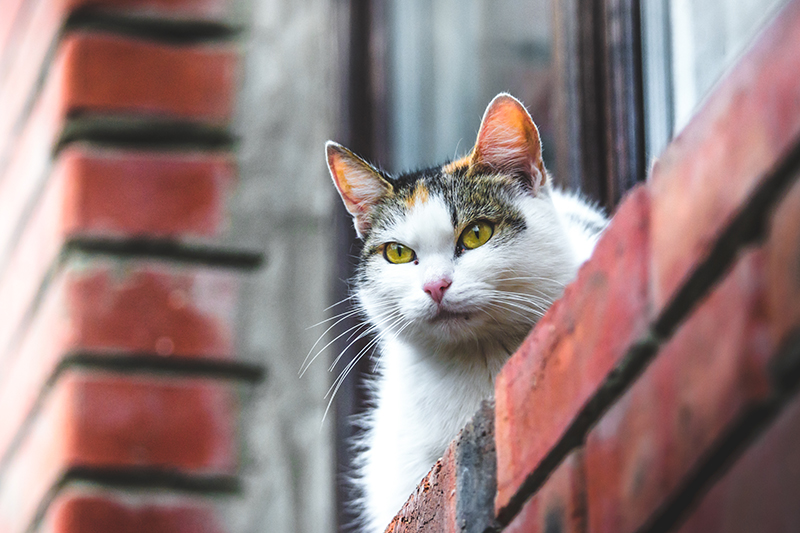How to Care for Outside Cats in the Winter

Wherever temperatures are dropping around the United States, people are taking extra steps to help outdoor cats in winter, making sure they stay safe and comfortable. Whether you own an outside cat, feed a stray, or carry out Trap-Neuter-Return (TNR) in your community, consider these tips to help outdoor cats as winter weather approaches.
Bring Your Cats Inside If You Can
Do you have cats who spend part of their time outdoors? During the winter, you might just want to bring them inside rather than debating if it’s too cold. If you provide cat trees and scratchers, windows to look out from, and play with your cats a lot, they won’t get bored while they’re indoors.
Provide Dry, Warm Shelters
The first thing you’ll want to do is provide dry, warm shelters for outdoor cats. These shelters should ideally be placed in a covered area, like on a porch or in a carport, and not where they’ll potentially get soaked by standing water. Dry, enclosed shelters give cats a place to escape the rain, snow, and cold winds. One solution is to buy a heated, water-resistant shelter made especially for cats. Look for shelters with heated beds designed to warm up to the cat’s normal body temperature. This makes sure the cats stay toasty warm when it’s really cold outside. These shelters should have easy exits in case a quick escape is needed. The exits should be just large enough to fit one cat at a time so bigger animals don’t move in and take over. A cheaper and simpler alternative is to provide an XL styrofoam container. Simply cut out a door and fill the space with straw or a heated pet mat.
Keep the shelters away from areas with a lot of foot traffic that could scare cats. If you can, try to put the shelters on a raised area that’s a couple inches off the ground, so it’s away from rain, snow, and insects.
Straw allows cats to burrow. Pillowcases loosely stuffed with packing peanuts and shredded newspaper also work. Replace straw and newspaper if moist or dirty, and wash and re-stuff pillowcases as needed. Don’t use blankets, towels or folded newspapers; they absorb body heat and chill cats who are lying on them. Forego hay too, which may irritate noses and cause allergic reactions.
Provide Plenty of Warmed Food and Water.
In the winter, cats use more calories to stay warm and hunting for prey can be tougher. They’ll need a little extra help from you. Try putting out slightly warmed canned food a couple times a day, while also providing plenty of dry kibble that won’t freeze. You’ll also want to provide plenty of fresh water in an area that’s ideally protected from wind and rain. Check it at least twice a day to make sure it’s not frozen.
Protect outdoor cats from hunger and thirst this winter by keeping their food and water from freezing. If you can do so without compromising the privacy and security of the shelter, place food and water near the shelter so the cats won’t have to travel far. One way to protect food and water is to place two shelters—doorways facing each other—two feet apart. Then create a canopy between them by securing a wide board from one roof to the other. Then put the food and water under the canopy.
A thick plastic water container that’s deep and wide is better-insulated than a thin plastic or ceramic container. A solar-heated water bowl can prevent or delay water and canned food from freezing. There are also electric heated water bowls that can be found on Amazon. If shelters are well-insulated, you can put bowls of dry or moist food inside them, far from the doorway. Even if the moist food freezes, the cats’ body heat will defrost it when they hunker down in their shelter. Don’t put water bowls inside the shelter. Water is easily spilled, and a wet shelter will feel more like a refrigerator than a warm haven. Do your best to keep water from freezing. We reccomend checking your outdoor cats food at least twice a day and freshen their water and food as needed.
To TNR or not to TNR community cats in winter?
Don’t attempt TNR activities in the winter unless you can return the cats to a warm shelter.
People may be concerned about performing trap-neuter-return during winter because they worry about releasing females who have had their stomachs shaved for surgery. But winter trapping has its advantages. There are far fewer pregnant cats, which makes for a less complicated surgery, and you’ll prevent the births of many kittens come spring, when the majority are born.
Before you start winter trapping, however, you must ensure that the cats will have adequate shelter when you return them to their territory. If you’ve followed the directions above, they’ll be in good shape.
Prepare for Major Snowstorms
In the event a major weather event like snow accumulation is in the forecast, give cats extra food and water in case you can’t get to the shelter. Clear snow from the entrances of cats’ shelters after snowstorms so they don’t get snowed in.
Don’t use salt or chemical melting products to clear snow. They can be lethal when licked off paws or ingested from melting puddles. They are also harmful to cats’ natural snowshoes—their paws! Keep antifreeze away from cats. Antifreeze is poison. Animals, including cats, find its taste irresistible. As little as a teaspoon of auto antifreeze spilled in your driveway can be fatal for a cat.
Don’t Forget to Check Your Car
Always check under the hood of your car for cats. Before you turn on your car engine, look under your car to make sure the coast is clear, and check to see that no cats have curled up in your engine during especially cold days. Give the hood a few taps to make sure a cat isn’t hiding there.
Share This Post
Recent Posts
About Shallowford Animal Hospital
Shallowford Animal Hospital and The Pet Spa at Shallowford are dedicated to the exceptional, compassionate care your pet deserves. Pets hold a very special place in our families, and we treat yours like our own.



